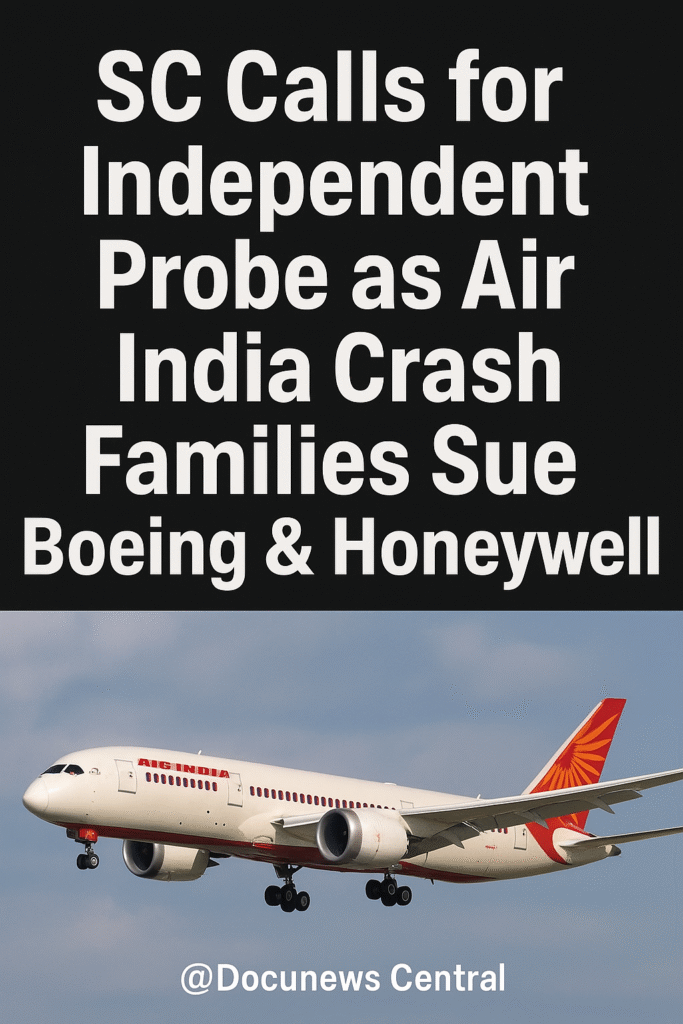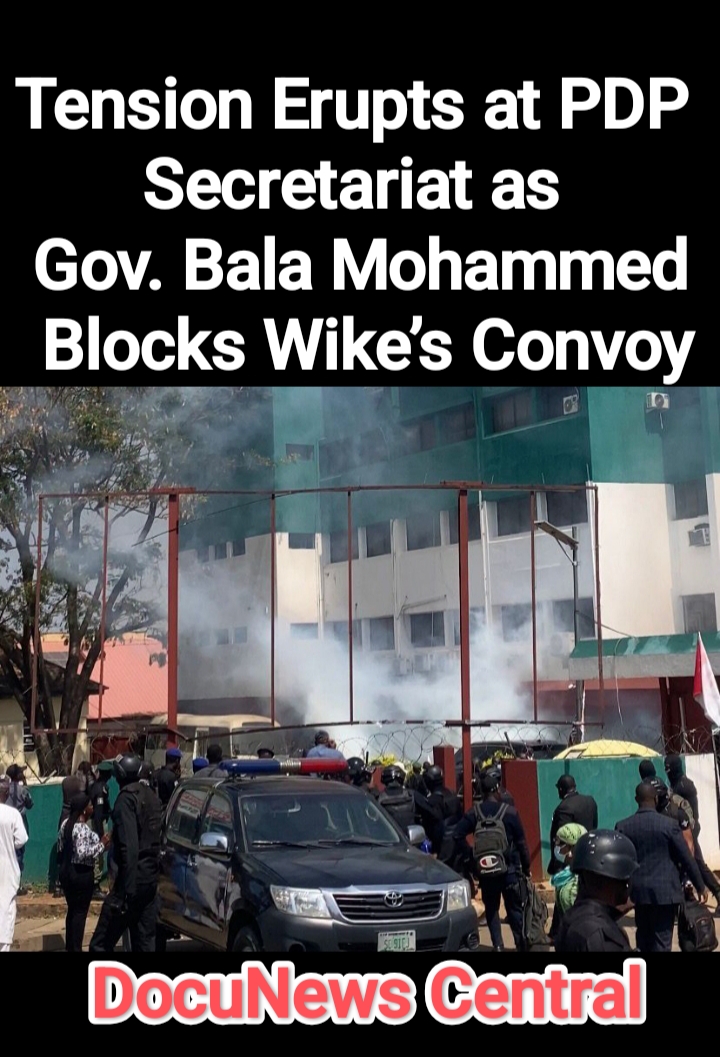

Air India Crash: Supreme Court Demands Independent Inquiry as Victims’ Families Sue Boeing and Honeywell in U.S. Court
Supreme Court Steps In
India’s Supreme Court has stepped into the tense debate over the fatal Air India crash of June 12, 2025. The court has asked the central government to answer a public interest plea that calls for an inquiry that is free from all conflict of interest. The petitioners insist that only an independent probe can reveal the full truth of what caused the tragedy.
The judges gave the government two weeks to reply. They also asked the Directorate General of Civil Aviation and the Aircraft Accident Investigation Bureau to present all technical records. This includes the black-box data and the cockpit voice recordings.
The move by the highest court reflects the growing public demand for a transparent investigation. Families of victims, pilots’ unions, and safety advocates have all raised concern that an internal probe might hide key facts.
Families Seek Justice
Four families who lost loved ones have gone beyond India’s legal system. They filed a lawsuit in the United States. The suit targets two major companies: aircraft maker Boeing and avionics supplier Honeywell. The families accuse both of negligence.
Their complaint claims that a faulty fuel-cutoff switch, designed and supplied by Honeywell and fitted on the Boeing 787, played a key role in the crash. The switch, they argue, did not respond when pilots tried to shut down one of the engines during a mid-air emergency.
They say that Boeing failed to ensure the part met the highest safety standards and that Honeywell did not warn operators about potential flaws. They are seeking compensation and punitive damages.
Tragedy of Flight 171
The crash happened on June 12 when Air India Flight 171 was flying from Mumbai to London. Two hundred and sixty people were on board. The aircraft went down near Ahmedabad shortly after takeoff.
Initial rescue teams found no survivors except one passenger, Vishwash Kumar Ramesh. He remains the sole survivor and is recovering from physical injuries and deep emotional trauma.
Investigators at first suspected bad weather or pilot error. But early findings from the Aircraft Accident Investigation Bureau pointed to cockpit confusion and a critical problem with the fuel-cutoff mechanism.
Why the Probe Matters
India’s aviation regulator normally handles such accidents. But critics argue that a domestic probe cannot be fully neutral when it must also regulate the same airlines and aircraft.
Safety advocates believe that an independent panel of global experts is vital. Such a body could examine engineering, maintenance, and flight operations without fear of pressure from political or commercial interests.
The Supreme Court’s decision to seek answers from the government is seen as a key step toward restoring public trust.
Technical Focus on the Fuel System
The heart of the families’ lawsuit and the petition before the Supreme Court is the plane’s fuel system. According to their lawyers, the fuel-cutoff switch did not function as designed during the emergency.
Pilots allegedly tried to stop the flow of fuel to a troubled engine. The switch failed to engage, causing a surge in power that led to an uncontrollable fire. The blaze spread through the wing and fuselage, forcing the jet into a rapid descent.
Experts explain that the fuel-cutoff system is a last line of defense. It must work instantly to prevent a fire from spreading. A malfunction at that stage can leave pilots with few options.
Boeing and Honeywell Respond
Boeing has stated that it will cooperate with all official investigations. The company expressed sympathy for the victims’ families but has not admitted any fault.
Honeywell issued a brief statement saying it is reviewing the allegations and is ready to share technical data with investigators. It also expressed sorrow for the loss of life.
Both companies face scrutiny not only from Indian authorities but now also from a U.S. court where the families filed their civil suit.
International Attention
The disaster has drawn global attention because Boeing 787 aircraft operate worldwide. Other airlines and aviation regulators are watching closely.
The U.S. Federal Aviation Administration has not grounded the model but said it is monitoring the inquiry. European and Asian aviation agencies have requested updates from India’s investigators.
Any confirmation of a design flaw could lead to a global safety directive or a mandatory replacement of the fuel-cutoff switch.
Voices of the Bereaved
Relatives of victims have spoken out in emotional press conferences. They demand accountability and say they will not rest until the full cause of the crash is known.
One family representative stated, “We cannot bring back those we lost, but we can fight to stop this from happening again.”
Another added that the legal action in the United States is not only about money. “This is about truth and justice,” the spokesperson said.
Survivor’s Ongoing Trauma
The only survivor, Vishwash Kumar Ramesh, continues to recover in a New Delhi hospital. Doctors say his physical wounds are healing but he is coping with deep psychological scars.
Friends say he now fears flying and suffers from nightmares about the crash. Counselors are providing therapy to help him process the trauma.
His testimony could become vital to both the Supreme Court petition and the U.S. lawsuit. He is expected to share details about the moments before the crash and the crew’s response.
Pressure on the Government
Opposition lawmakers have pressed Prime Minister Narendra Modi’s government to support an independent probe. They argue that transparency is essential for public confidence.
Aviation unions have echoed these calls, saying that pilots and crew must trust that equipment is safe and that failures will be fully exposed.
The government has so far said only that it will study the Supreme Court’s request and provide a formal reply within the deadline.
Possible Global Repercussions
If the court-ordered investigation finds a design flaw, Boeing and Honeywell could face large financial claims. Airlines around the world might need to inspect or replace the same fuel-cutoff parts.
Insurance costs for operators of the Boeing 787 could rise. Investors are already watching Boeing’s stock, which fell slightly after news of the Supreme Court action and the U.S. lawsuit.
Honeywell’s shares also dipped amid concern that its equipment could be at fault.
Next Steps in the Supreme Court
The Supreme Court will reconvene after receiving the government’s reply. It could then appoint a special panel of independent experts. The court may also order the release of black-box data to the public.
Legal analysts say the case could become a landmark in India for how aviation disasters are investigated. A ruling that mandates independence could set a precedent for future crashes.
The Road Ahead
For the families of the 259 victims, the process has only begun. They face long court battles in both India and the United States.
A full investigation may take many months. Technical studies of the fuel system will need careful testing.
Meanwhile, public interest in aviation safety has surged. Passengers and airline staff are asking questions about maintenance and the reliability of critical aircraft systems.
Conclusion
The Supreme Court’s call for an independent inquiry and the lawsuit in the United States together mark a turning point in the search for truth about the Air India Flight 171 disaster.
They signal that families and citizens will not settle for partial answers. They want clear facts and firm accountability.
As the legal and technical processes unfold, the world will be watching. The outcome will shape not only the future of Air India and the victims’ families but also the safety standards of global aviation.







Hi,
I hope you’re doing well. I know you receive many emails like this, but I only need 2 minutes of your time.
Do you want to grow your business online and generate more leads? If yes, I can help with:
1. Full website audit to highlight quick wins (page speed, meta tags, mobile-optimization)
2. Keyword research & competitive analysis to target high-value opportunities
3. Content & on-page SEO improvements
4. Backlink strategy to build authority and visibility
Please send me your website link along with target keywords & locations. Our expert team will analyze these and share a full audit report and package details.
Looking forward to hearing from you soon.
Regards,
Surabhi
President Bola Tinubu declines to sign two National Assembly bills
3 clicks instead of 30 tools. Delegate the grind to AI and keep the profit https://www.youtube.com/watch?v=GY1x2NWs9EA
You want to advertise in my site?
For this advert. You would have sent a small token
No backlinks. No waiting. Just #1 on Google in minutes: https://www.youtube.com/watch?v=ut65EZBjArc
Working hard every day but still barely moving forward? It’s time to stop the endless grind.
Discover how people are earning real money from trading — no office, no boss, no limits.
One simple app could be your ticket to financial freedom: https://youtu.be/VmHYisHHOtU
to UNSUBSCRIBE:
https://casatemporada.site/unsubscribe?domain=docunewscentral.com
Address: 108 West Street Comstock Park, MI 48721
If you want advert while not contact me than to do it this wey. Well I will still approve it. But not time don’t do it this wey.
Give me a do follow backlink
Discover The Easy New Way We’re Getting Paid Multiple Times A Day From A Hidden Source!
https://www.novaai.expert/TheHiddenGoldmine
to UNSUBSCRIBE:
https://www.novaai.expert/unsubscribe?domain=docunewscentral.com
Address: 209 West Street Comstock Park, MI 49321
We flipped the game on its head.
We give people what they want BEFORE they buy!?!?
The Money comes in for us 500 a pop all day every day!
https://smartexperts.pro/500aPop
to UNSUBSCRIBE:
https://smartexperts.pro/unsubscribe?domain=docunewscentral.com
Address: 209 West Street Comstock Park, MI 49321
How we Turn ordinary pictures into profit-making marketing machines in seconds – even if you’ve never designed anything before.
Grab it today – Limited Free PLR License Included!
https://smartexperts.pro/NanoBananaTurbo
to UNSUBSCRIBE:
https://smartexperts.pro/unsubscribe?domain=docunewscentral.com
Address: 209 West Street Comstock Park, MI 49321
With Just 3 Clicks, You Will Be Able To Unlock All TOP AI Models with All Versions + All Upcoming Future Versions… Without Spending A Penny …
https://bravo-333.site/MultiverseAI
to UNSUBSCRIBE:
https://bravo-333.site/unsubscribe?domain=docunewscentral.com
Address: 209 West Street Comstock Park, MI 49321
World’s FIRST AI System That Creates PROFITABLE Amazon Books In Under 6 Minutes Across 25+ Niches
https://goldsolutions.pro/RoyaltyProfitsAI
to UNSUBSCRIBE:
https://goldsolutions.pro/unsubscribe?domain=docunewscentral.com
Address: 209 West Street Comstock Park, MI 49321
SOFTWARE: New AI Cloud-Tool Quietly Turns Simple Ideas Into Passive Royalties….
…No tech. No product. No audience. Just this one AI tool.
https://www.novaai.expert/OhanashiGenAI
to UNSUBSCRIBE:
https://www.novaai.expert/unsubscribe?domain=docunewscentral.com
Address: 209 West Street Comstock Park, MI 49321
How Everyday People Are Turning
Free AI Videos Into $500+ Days…
While Chillin’ On Their Phone / Computer?
https://smartexperts.pro/Vyralzz
to UNSUBSCRIBE:
https://smartexperts.pro/unsubscribe?domain=docunewscentral.com
Address: 209 West Street Comstock Park, MI 49321
THE FASTEST WAY TO CREATE, PUBLISH, & PROFIT
FROM EBOOKS… NO WRITING REQUIRED
PROFIT-READY EBOOKS with covers, TOC, chapters, sections, links, images, & content!
https://viewbet-24.site/eBookWriterAI
to UNSUBSCRIBE:
https://viewbet-24.site/unsubscribe?domain=docunewscentral.com
Address: 209 West Street Comstock Park, MI 49321
How Everyday People Are Turning
Free AI Videos Into $500+ Days…
While Chillin’ On Their Phone / Computer?
https://smartexperts.pro/Vyralzz
to UNSUBSCRIBE:
https://smartexperts.pro/unsubscribe?domain=docunewscentral.com
Address: 209 West Street Comstock Park, MI 49321
This Invisible 10-Minute Faceless Video Hack
Pulled in 628,000+ Views…
With No Camera, No Gear & No Tech Skills
https://443w.site/InvisibleTrafficSystem
to UNSUBSCRIBE:
https://443w.site/unsubscribe?domain=docunewscentral.com
Address: 108 West Street Comstock Park, MI 48721
This Isn’t A Course. It’s A Fully Functional,
Done-For-You Business… Powered Entirely By AI
https://askthis.site/ConverslyAI
to UNSUBSCRIBE:
https://askthis.site/unsubscribe?domain=docunewscentral.com
Address: 108 West Street Comstock Park, MI 48721
Multiverse AI – The Only Platform That Gives You Access To Every Top AI Model — In Every Version — All Inside A Single, Beautifully Simple Dashboard.
https://1x-slots.site/MultiverseAI
ChatGPT (3.5 → 4.5 → 4o → 5 → Turbo → Nano)
Gemini (1.5 Pro → 2.0 Flash)
Claude (3 Opus → Sonnet → Haiku)
Grok (1 through 4)
DALL·E, Veo, Kling, ElevenLabs, DeepSeek, FLUX, LLaMA & more
And yes — you get every future version included automatically.
https://1x-slots.site/MultiverseAI
to UNSUBSCRIBE:
https://1x-slots.site/unsubscribe?domain=docunewscentral.com
Address: 108 West Street Comstock Park, MI 48721